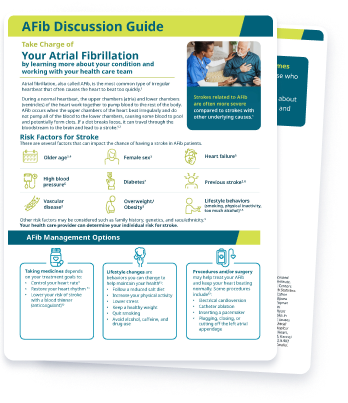Managing Your
AFib & Risk of Stroke

What Can You Do to Manage AFib and Lower Your Risk for Stroke?
Atrial fibrillation (AFib) and your risk of stroke can be managed with medicines, lifestyle changes, procedures, and/or surgery.1 Your health care provider can discuss your overall health and the potential treatment options that are right for you.
There are treatment options your health care provider may prescribe to help control your AFib.
Depending on your AFib treatment goals, medicines may help as follows:
Rate Control
Slow the heart rate so the heart does not beat too quickly during AFib2
Rhythm Control
Restore the heart’s rhythm to a normal state and keep it there (for example, antiarrhythmic medicines)1
Lower Risk of Stroke
Blood thinners may help lower stroke risk by reducing your risk of blood clots forming1
The following are behaviors you can change to maintain a healthier lifestyle1:
- Follow a healthy diet
- Increase your physical activity
- Lower stress
- Keep a healthy weight
- Quit smoking
- Avoid alcohol, caffeine, and drug use
- Lower your blood pressure
The following procedures may help treat your AFib and keep your heart beating normally, especially if lifestyle changes and medicines do not improve your symptoms1:
- Electrical cardioversion
- Catheter ablation
- Inserting a pacemaker
- Plugging, closing, or cutting off the left atrial appendage
Take Charge of
Your Atrial Fibrillation
by learning more about your condition and working with your health care team
To support your journey, the AFib Discussion Guide provides a list of frequently asked questions to help you talk with your health care provider about managing your AFib.


What Are Blood Thinners?
Blood thinners, also called anticoagulants, are medicines that help prevent blood clots. They may be prescribed to help reduce the risk of stroke in patients with AFib. Despite their name, blood thinners do not really make the blood “thin.” Instead, they reduce the stickiness of the blood, making it harder for clots to form.3
Bleeding is a common side effect of blood thinner use. Often, bleeding is minor, such as bruising or cuts that may take more time to stop bleeding. But life-threatening bleeding is possible.4

MORTY, AGE 72*
“My doctor and I decided that it is important for me to take a blood thinner to help reduce my risk for having a stroke due to AFib.”
*Not a real patient.

The benefit of preventing stroke may, but not always, outweigh the bleeding risk.5
Talk to your health care provider about what is right for you.
- Atrial fibrillation: treatment. National Heart, Lung, and Blood Institute. Accessed May 24, 2023. https://www.nhlbi.nih.gov/health/atrial-fibrillation/treatment
- Atrial fibrillation medicines. American Heart Association. Updated March 27, 2023. Accessed July 26, 2023. https://www.heart.org/en/health-topics/atrial-fibrillation/treatment-and-prevention-of-atrial-fibrillation/atrial-fibrillation-medications
- Types of heart medications. American Heart Association. Updated January 15, 2020. Accessed May 24, 2023. https://www.heart.org/en/health-topics/heart-attack/treatment-of-a-heart-attack/cardiac-medications
- National Blood Clot Alliance and the Atlantic Quality Innovation Network. Anticoagulation management: what to expect when surgery or other medical or dental procedures are planned. Accessed May 24, 2023. https://www.stoptheclot.org/wp-content/uploads/2017/11/AC-Management-What-to-Expect-IPRO.pdf
- Lip GYH, Banerjee A, Boriani G, et al. Antithrombotic therapy for atrial fibrillation: CHEST Guideline and Expert Panel Report. Chest. 2018;154(5):1121-1201. doi:10.1016/j.chest.2018.07.040